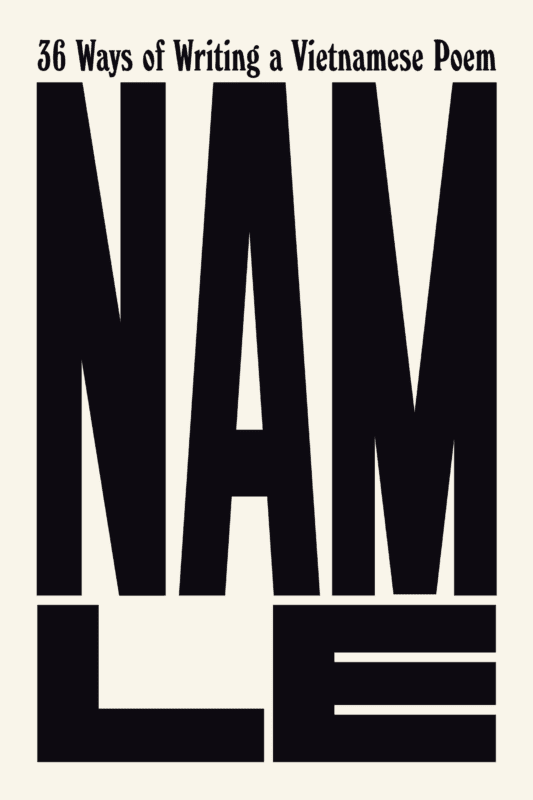
“Why should, say, the work of ‘ethnic’ writers … remain charged with extra onuses of representation, explanation and authenticity?” asks writer and poet Nam Le in his essay “A Great Lake”. “Is it actually impossible for a work by a ‘Vietnamese’ writer in the West to be evaluated without this unifocal historical knowingness? Without presumed psychodramatic intimacy? Without a framework of imputed, all-smothering victimhood?” Le’s debut poetry collection, 36 Ways of Writing a Vietnamese Poem, challenges this label of “Vietnamese” in the publishing industry. As a Vietnamese writer from Australia, Le interrogates the perceptions of Vietnamese poetry within the violent politics of the English language and literature, where Vietnamese subjectivity has been caricatured, consumed, and construed by white writers and readership. Le’s poems distill the violent relationship between the oppressive “You” and the marginalized “I” with bold manifesto-like language.
Even before referencing literary themes and tropes expected of diasporic Vietnamese poetry, the opening stanza of the collection’s first poem, “[1. Diasporic]” immediately interrogates the reader’s expectations of language:
“In English, mind You.
You dink I writee Yiknamee?
Shame on You.
It was Your violence dumbed me”
“You” possesses power, establishing linguistic and cultural hegemony through colonization. The speaker rebukes the perpetrator “You” with certainty. “It was Your violence dumbed me” is an accusation underscoring how ironic it is for the perpetrator to demand some authentic performance of being Vietnamese through the Vietnamese language, when the legacy of Western imperialism and generations of displacement had violently severed the speaker from the mother tongue.
While the speaker’s focused anger lends clarity to the first part of the poem, the middle section is more ambiguous in meaning. The colonizer “moved me,” displacing the speaker “From everything I didn’t know / I didn’t know / I would’ve known / You would’ve known.” The syntactical breakdown of these four lines reflects the speaker’s instability in knowledge about the homeland they had to flee and cannot remember. The four statements spiral desperately around what is not known or could have been known, never able to arrive at what is known. The inability to know about one’s origins is a loss that compounds over time, and the speaker incriminates the colonizer for fracturing his identity; one’s culture cannot be preserved intact through war and genocide. Le breaks up the word “displacement” in the next lines: “Dis place ment / Everything to me.” The pronunciation is a continuation of the Vietnamese accent that the speaker mocks in the first stanza. This line also suggests how displacement can be an all-consuming identity—for example, affecting how the works of an artist of the diaspora is perceived or prescripted to mean.

The speaker’s vulnerable words ultimately shift the poem from the charged “Shame on You” to now, a defused, reflective “Shame on me” in the final stanza:
“Shame on me.
What do I know?
What’s Vietnamese in me
Could fit in a poem.”
Le returns to the question of what diasporic subjects can know. Writers grasp at fragmented memories and imperfect knowledge as they find words to describe the harm they’ve experienced. The speaker seems to reduce his Vietnamese identity to “fit” in a poem, like fitting in and assimilating. But the poetic genre can be superfluous and ever expansive. 36 Ways of Writing a Vietnamese Poem is thus an experimental project of processing Vietnamese subjectivity in poetry. The themes of violence and knowledge in “[1. Diasporic]” remain central in the rest of the collection.
The language of Le’s poetry is brusque and cerebral, where the speaker and Vietnamese subjects feel far away—safely distanced from the colonizer. Many poems read like manifestos, with multiple poems titled “Violence” and sub-categorized as “Taxonomic,” “Auto-logous,” or “Patri-confessional.” This focus on the empire’s violence decenters palatable narratives of victimhood that Western audiences have disturbingly grown comfortable hearing. “But think about the children, super cute children,” begins the speaker in the poem “[7. Violence: Paedo-affective]”. Le then dispels the image of “preternaturally wise” victims of war, shifting to the experiences of children who do “break free” from war conditions but grow up in “Western, Educated, Industrialised, Rich, Democratic (WEIRD)” countries. In WEIRD countries, they continue to be “hypersexualised”, “desexualised”, “never fully anything.” Think of what you do (or don’t) for these children of immigrants who you interact with everyday, Le seems to ask the reader – the children who are “trying, playing their part, / which is no part, or a rote, taken part, / a strenuous decor, to be praised, paid, patronised, / their names mispronounced as though being done / a favour.”
While raw and brutalist in its self-critique, Le’s poetry also grants grace to the immigrant child who becomes a writer. In “[4. Aegic / All-encompassing],” Le gives permission to a diaspora kid to claim their parents’ trauma “to take and tell” because “it’s all yours – by blood. / By right. By wrong done to your blood” and “Your blood contains it.” As Le explores in his short story “Love and honour and pity and pride and compassion and sacrifice…” from his 2008 collection The Boat, choosing to write about family trauma as a person of color is complicated, especially when your family members want to move on from the past. The title channels the strength and protection of ancestors for their descendents to remember and tell their family’s story.
At the Portland stop on his book tour, Le shared that 36 Ways has been a project of twenty years in the making. It is exciting that many diasporic Vietnamese poets have entered the literary scene since then, introducing the Western audience to a diverse set of subjects, tones, and styles of Vietnamese poetry. The composition of a 37th poem in Le’s collection testifies to Vietnamese poetry as a timeless and expansive project of defining the Vietnamese self in the West. Le’s poetic inquiries into the violence of language and the archives fully realize Viet Thanh Nguyen’s statement about the identity crisis of the writer “supposedly caught in the middle of East versus West” –rather than a cultural crisis, it is a “political crisis that arises from the Western invasion and colonization and continuing domination of Asia.”
36 Ways of Writing a Vietnamese Poem
by Nam Le
Knopf
 Cathy Duong is a current Masters student at UW Seattle Genetic Counseling program. In her free time, she enjoys traveling to Little Saigons, playing V-pop on her ukulele, and analyzing diasporic Viet literature.
Cathy Duong is a current Masters student at UW Seattle Genetic Counseling program. In her free time, she enjoys traveling to Little Saigons, playing V-pop on her ukulele, and analyzing diasporic Viet literature.


